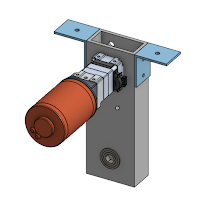For our 2017 robot, we were really happy with our aluminum tube drive modules. We designed them to connect to the VersaPlanetary gearbox, with a CIM or miniCIM at the top. A pulley and belt system (same size, though you could manipulate that for mechanical advantage) transferred the motion from the top to the bottom, where we had omni or mecanum wheels. We like this design because we had, until then, been using a direct drive model. Even when we've used belt or tank drive before, the motors were placed at the level of the wheels, constraining under-robot space. These drive modules enabled us to pull the motors up off the ground, raise our center of gravity if necessary, and create opportunities for manipulators that operate low to the ground.
 |
| 2017 Drive Module Rendering |
 |
| 2017 Assembled Drive Module |
This year, we are using a six-wheeled omni holonomic drive system, and we expect some pretty hefty manipulators to compete in FIRST PowerUp, so we revisited our drive module. Completely assembled, the 2017 drive modules were about 6 pounds. Our first priority was to reduce weight by excavating non-essential aluminum while retaining structural integrity. With all the designed in cavities, we shaved about 0.8 pounds off the drive module, which totals to 4.8 pounds of savings over a six-wheeled robot. An added bonus to this modification was a much easier assembly with all the extra holes for tools and fingers, plus, the increased visibility enables us to troubleshoot much more easily.
 |
| 2018 Assembled Drive Module |
 |
2018 Drive Module Model
|




